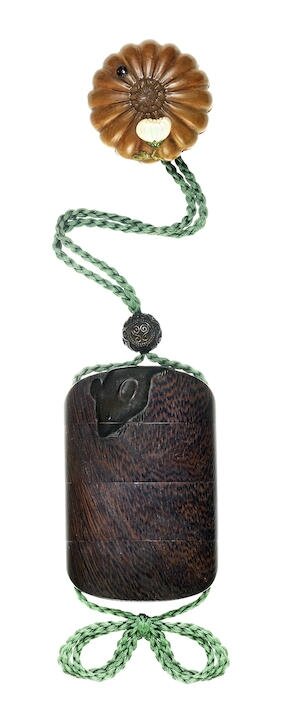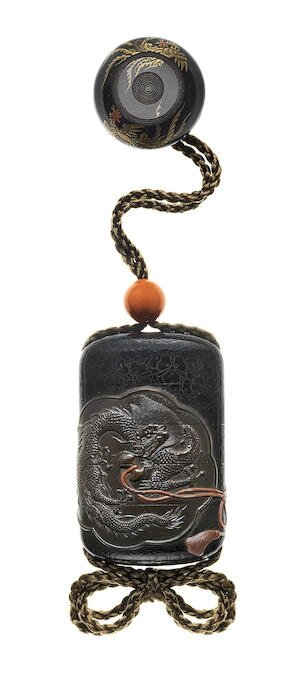Misumi collection triumphs with second "white glove" sale at Bonhams
Shibata Zeshin’s works also included an album of 18 urushi-e paintings, which sold to a bidder in the room for £108,100, seven times its pre-sale estimate of £15,000 – 20,000. Photo: Bonhams.
LONDON.- Part II of Bonhams’ Misumi Collection series witnessed 100% of lots sold. The 10 November sale repeated last year’s sell-out auction of the first part of the collection, which was also a ‘white glove’ sale.
Shibata Zeshin’s Door with Autumn Maple-Viewing Scene, shortlisted for this year’s ‘Asian Art in London’ prize, led The Misumi Collection Part II: Important Works of Lacquer Art and Paintings, which took place at Bonhams New Bond Street. Selling for £350,000, it more than tripled its pre-sale estimate of £100,000 – 150,000.
The auction featured a number of masterpieces by Zeshin, Japan’s most celebrated lacquer artist.
His works also included an album of 18 urushi-e paintings, which sold to a bidder in the room for £108,100, seven times its pre-sale estimate of £15,000 – 20,000.
Admired by Western collectors for well over a century, Shibata Zeshin (1807 – 1891) was one of the most famous names of the late Edo and Meiji era art world.
A number of Zeshin’s inro also sold for well over their estimates. Inro with Mouse well exceeded its pre-sale estimate of £30,000 – 35,000 to sell for £47,500, while Inro with Antique Mirrors, estimated at £40,000 – 60,000, sold for £64,900.
Shibata Zeshin 柴田是真 (1807–1891) Inro with Mouse 二十日鼠図蒔絵印籠, Meiji era (1868–1912), circa 1870–1890. Sold for £47,500 (€67,280). Photo: Bonhams.
Shibata Zeshin 柴田是真 (1807–1891), Inrō with antiques mirrors 古鏡図蒔絵印籠, Meiji era (1868–1912), circa 1870–1890. Sold for £64,900 (€91,926). Photo: Bonhams.
“The competitive bidding was a resounding endorsement of the world’s longstanding admiration for the artist and the continued success of the auctions aptly reflects the exceptional eye of the collector,” said Suzannah Yip, Bonhams Director of Japanese Art.
Part I and Part II of the Misumi auctions (comprising 34 lots only) now total £2,274,625.
Shibata Zeshin (1807-1891) began his prolific and versatile career at 11-years old as an apprentice, but rapidly gained a reputation for the naturalistic style of painting that came into vogue with the arrival of European traders.
Zeshin lived in turbulent times. In 1867-8 the centuries-old government of the shoguns was swept away by a coalition of reformist samurai, and the youthful Emperor was installed as a European-style constitutional monarch ruling from Zeshin’s native city, which was renamed Tokyo. Japan’s new-found globalism was an inspiration to Zeshin, whose exposure to the formats and techniques of western art in the early years of the Meiji Era (1868-1912) had revolutionary artistic results, which are readily apparent in the works of the Misumi Collection. One of them was his development of urushi-e, paintings of wet lacquer applied to paper. This daring new method, so different from traditional maki-e (lacquer sprinkled with gold or silver powder as a decoration) was clearly intended to emulate oil painting on canvas.
It is at this time that Zeshin must have first seen framed oil paintings and was inspired to create a series of large scale lacquer panels with bold, unified compositions and lavish use of the many new maki-e techniques that he had invented over the decades. His first panel, a landscape of Mount Fuji, was exhibited at the Vienna World Exposition of 1873, a potent symbol of Japan’s determination to blend the traditional and the foreign and forge a new artistic identity. The cover lot for this year’s sale, a paulownia-wood door panel featuring an autumn maple-viewing scene (estimate £100,000-150,000), exemplifies this revolutionary development.
The leaders of the new government quickly recognized the soft-power potential of Japan’s traditional arts and crafts and frequently commissioned Zeshin to execute commissions for international exhibitions and the imperial palaces; in the year he died he was even named one of the first Teishitsu Gigeiin (Artist to the Imperial Household, a forerunner of today’s Living National Treasure).
While Zeshin was revered in his home country during his lifetime, in death, his fame was diminished by the tumultuous events of Japan’s break-neck modernisation. Fortunately his work never fell from favour with the American and European collectors whose fascination with him dates back to those first international expositions. It is mostly thanks to this foreign enthusiasm that Zeshin’s stock has now risen so dramatically in his own land.

/https%3A%2F%2Fprofilepics.canalblog.com%2Fprofilepics%2F1%2F0%2F100183.jpg)
/https%3A%2F%2Fstorage.canalblog.com%2F03%2F02%2F119589%2F96711876_o.jpg)
/https%3A%2F%2Fstorage.canalblog.com%2F11%2F31%2F119589%2F94773502_o.jpg)
/https%3A%2F%2Fstorage.canalblog.com%2F20%2F83%2F119589%2F94772815_o.jpg)
/https%3A%2F%2Fstorage.canalblog.com%2F26%2F72%2F119589%2F75604929_o.jpg)
/https%3A%2F%2Fstorage.canalblog.com%2F59%2F60%2F119589%2F26458628_o.jpg)





/http%3A%2F%2Fstorage.canalblog.com%2F13%2F37%2F119589%2F129550780_o.jpg)
/http%3A%2F%2Fstorage.canalblog.com%2F47%2F91%2F119589%2F110611313_o.jpg)
/http%3A%2F%2Fstorage.canalblog.com%2F36%2F15%2F119589%2F110611160_o.jpg)
/http%3A%2F%2Fstorage.canalblog.com%2F22%2F38%2F119589%2F110611054_o.jpg)